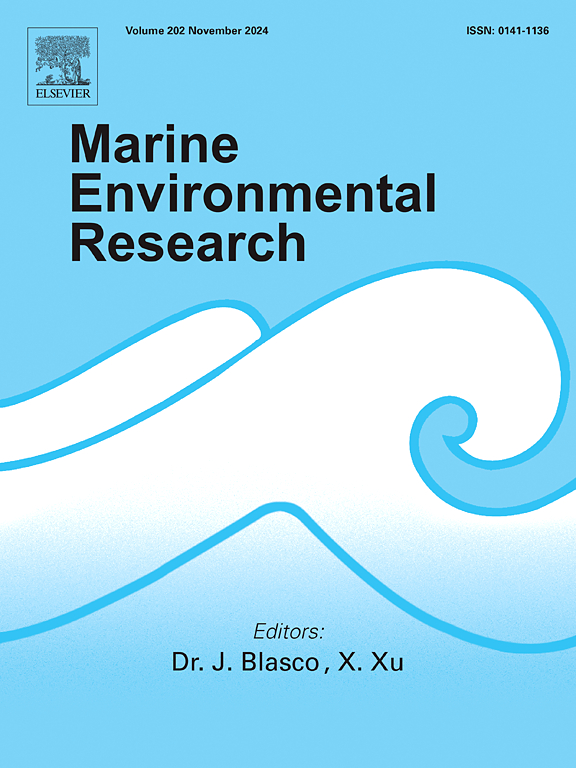Temporal variability and ecological risks of pharmaceuticals and cocaine during the Christmas and New Year holidays in a beach area of North Coast of São Paulo, Brazil
IF 3
3区 环境科学与生态学
Q2 ENVIRONMENTAL SCIENCES
引用次数: 0
Abstract
This study assessed the occurrence and ecological potential risk of nine selected pharmaceuticals in water samples from the Juquehy River. The river flows continuously to Juquehy Beach, known as “the jewel of the north coast" of São Paulo, Brazil. Samples were collected during Christmas and the New Year (period of December 2023–January 2024), in addition to a previous baseline weekend, to compare the loads during “celebratory parties" versus “normal operational conditions." The findings indicated that the “mass gathering" during Christmas and New Year holidays contributed significantly to an increase of the mass load of the nine pharmaceuticals flowing along to the Juquehy River, i.e., caffeine (14.40–633.00 ng/L) > losartan (<LOQ: limit of quantification to 9.43 ng/L) > furosemide (< LOQ to 9.16 ng/L) > diclofenac (0.61–4.55 ng/L) > carbamazepine (< LOQ to 0.73 ng/L) > orphenadrine (< LOQ to 0.11 ng/L) showed higher concentrations during the New Year holiday. Conversely, atenolol (< LOQ to 13.10 ng/L) > benzoylecgonine (0.33–7.23 ng/L) > cocaine (0.12–6.59 ng/L) showed higher concentrations during the Christmas day. The individual ecological risk assessment in the Juquehy River revealed a clear environmental concern for the aquatic ecosystem. The threat to the aquatic biota is significant, with caffeine and losartan presenting a moderate level of risk. Moreover, the mixture ecological risk assessment of nine compounds indicates acute moderate risks to algae, crustaceans, and fishes, as well as chronic low risks to fishes.

巴西圣保罗北海岸海滩地区圣诞节和新年假期期间药物和可卡因的时间变化和生态风险
本研究评估了 Juquehy 河水样本中九种选定药物的存在情况和生态潜在风险。该河流源源不断地流向被誉为巴西圣保罗 "北海岸明珠 "的 Juquehy 海滩。在圣诞节和新年期间(2023 年 12 月至 2024 年 1 月),除了之前的基线周末外,还采集了样本,以比较 "庆祝派对 "和 "正常运行条件 "期间的负荷量。研究结果表明,圣诞节和新年期间的 "集体聚会 "大大增加了流向 Juquehy 河的九种药物的质量负荷,即咖啡因(14.40-633.00 ng/L);洛沙坦(LOQ:定量限为 9.43 ng/L);呋塞米(LOQ:定量限为 9.16 ng/L);双氯芬酸(0.61-4.55纳克/升)、卡马西平(LOQ为0.73纳克/升)、奥芬那定(LOQ为0.11纳克/升)在元旦假期期间浓度较高。相反,阿替洛尔(LOQ:13.10 ng/L)、苯甲酰可待因(0.33-7.23 ng/L)和可卡因(0.12-6.59 ng/L)在圣诞节期间的浓度较高。对 Juquehy 河进行的个别生态风险评估显示,水生生态系统存在明显的环境问题。咖啡因和洛沙坦对水生生物群的威胁很大,属于中度风险。此外,对九种化合物进行的混合物生态风险评估显示,藻类、甲壳类动物和鱼类面临急性中度风险,鱼类面临慢性低度风险。
本文章由计算机程序翻译,如有差异,请以英文原文为准。
求助全文
约1分钟内获得全文
求助全文
来源期刊

Marine environmental research
环境科学-毒理学
CiteScore
5.90
自引率
3.00%
发文量
217
审稿时长
46 days
期刊介绍:
Marine Environmental Research publishes original research papers on chemical, physical, and biological interactions in the oceans and coastal waters. The journal serves as a forum for new information on biology, chemistry, and toxicology and syntheses that advance understanding of marine environmental processes.
Submission of multidisciplinary studies is encouraged. Studies that utilize experimental approaches to clarify the roles of anthropogenic and natural causes of changes in marine ecosystems are especially welcome, as are those studies that represent new developments of a theoretical or conceptual aspect of marine science. All papers published in this journal are reviewed by qualified peers prior to acceptance and publication. Examples of topics considered to be appropriate for the journal include, but are not limited to, the following:
– The extent, persistence, and consequences of change and the recovery from such change in natural marine systems
– The biochemical, physiological, and ecological consequences of contaminants to marine organisms and ecosystems
– The biogeochemistry of naturally occurring and anthropogenic substances
– Models that describe and predict the above processes
– Monitoring studies, to the extent that their results provide new information on functional processes
– Methodological papers describing improved quantitative techniques for the marine sciences.
 求助内容:
求助内容: 应助结果提醒方式:
应助结果提醒方式:


